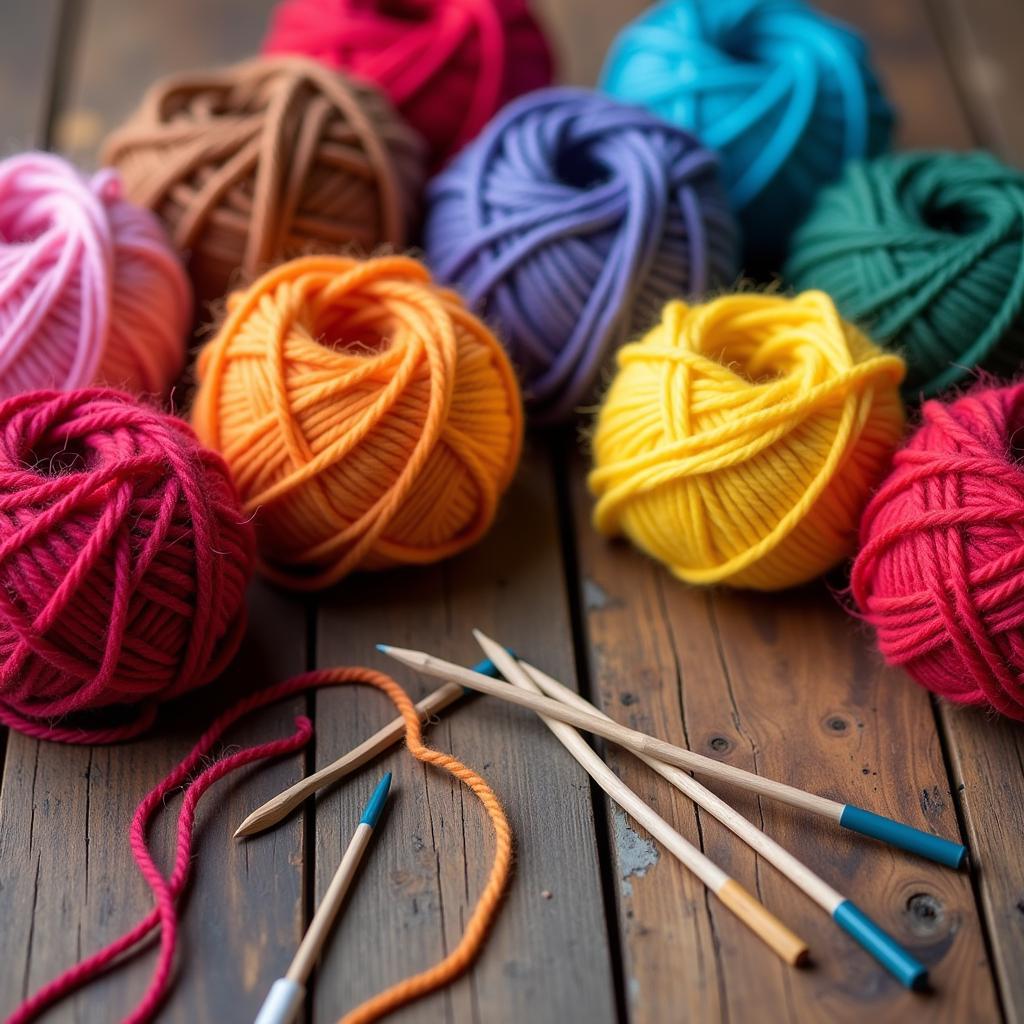Knitting with multiple colors opens a world of possibilities, allowing you to create intricate designs, vibrant stripes, and playful colorwork. Whether you’re a seasoned knitter looking to expand your skills or a beginner eager to dive into the colorful world of stranded colorwork, this guide will provide you with the knowledge and confidence to knit with multiple colors like a pro.
 Knitting needles and yarn in various colors
Knitting needles and yarn in various colors
Choosing Your Colors
Selecting the right color combinations can make or break your knitting project. Consider the following factors:
- Project: The purpose and style of your project will influence your color choices. For example, a baby blanket might call for pastel shades, while a bold scarf could feature contrasting hues.
- Yarn Weight: Using yarns of the same weight ensures your stitches will be consistent and your fabric will lie flat.
- Fiber Content: Different fibers take dye differently, so it’s best to use yarns with similar fiber content for even color distribution.
- Personal Preference: Ultimately, the best color combinations are those that you find visually appealing and inspiring.
Techniques for Knitting with Multiple Colors
There are several techniques for incorporating multiple colors into your knitting:
1. Stripes and Color Blocks
Creating stripes or color blocks is the simplest way to introduce multiple colors to your knitting. To switch colors, simply drop the old yarn and pick up the new yarn at the beginning of the row.
Tips for Seamless Stripes:
- Twist Your Yarns: When changing colors, twist the old and new yarns together once to prevent holes from forming.
- Carry Yarn Up the Side: For small stripes or color blocks, carry the unused yarn up the side of your work, weaving it in every few rows to prevent long floats.
2. Intarsia Knitting
Intarsia knitting is a technique used to create large blocks of color or picture patterns. Unlike stripes, each color is worked from a separate ball of yarn, and the yarns are twisted at the back of the work to prevent holes.
When to Choose Intarsia:
- Large areas of solid color
- Picture knitting
- Designs with minimal color changes within a row
3. Stranded Colorwork
Stranded colorwork, also known as Fair Isle knitting, involves knitting with two or more colors per row, creating intricate patterns with small blocks of color. The unused yarn is carried along the back of the work, creating “floats.”
When to Choose Stranded Colorwork:
- Intricate, geometric patterns
- Traditional Fair Isle designs
- Projects with frequent color changes within a row
Tips for Successful Stranded Colorwork:
- Maintain Even Tension: Keep your floats loose enough to avoid puckering the fabric but not so loose that they snag.
- Catch Floats Regularly: Catch long floats by weaving them into the work every few stitches.
- Use a Colorwork Chart: Colorwork charts provide a visual guide for your knitting, ensuring accurate stitch placement and color changes.
[how to add a new color when knitting](https://colorbox.com.vn/how-to-add-a new-color-when-knitting/)
Tips for Working with Multiple Colors
No matter which technique you choose, these tips will help you achieve polished results:
- Use Stitch Markers: Stitch markers are invaluable for keeping track of color changes, pattern repeats, and stitch counts.
- Block Your Finished Project: Blocking evens out stitches, enhances stitch definition, and gives your finished piece a professional look.
- Practice Makes Perfect: Don’t be afraid to experiment and make mistakes. The more you practice, the more confident you’ll become.
“Mastering the art of knitting with multiple colors requires patience, practice, and a keen eye for detail. Remember to start with simple projects and gradually challenge yourself with more complex designs. The satisfaction of creating a beautiful, hand-knitted piece with multiple colors is well worth the effort.” – Sarah Jones, Master Knitter and Colorwork Expert
Conclusion
Knitting with multiple colors opens up a world of creative possibilities, allowing you to infuse your projects with personality and flair. By understanding the different techniques, choosing your colors wisely, and practicing consistently, you can master this rewarding skill and create stunning knitted pieces that showcase your unique style. So grab your needles, select your favorite yarns, and embark on a colorful knitting adventure!
FAQs
1. Can I use any type of yarn for colorwork?
While you can technically use any yarn, it’s best to choose yarns of the same weight and fiber content for optimal results.
2. How do I prevent holes when changing colors?
Twist the old and new yarns together once when changing colors to close the gap and prevent holes.
3. What is the best way to weave in ends when working with multiple colors?
Weave in ends on the wrong side of the work, following the path of the yarn to secure them discreetly.
4. Can I knit with multiple colors on circular needles?
Yes, you can use circular needles for colorwork, especially for larger projects like sweaters or blankets.
5. Where can I find colorwork knitting patterns?
Numerous online resources, knitting books, and magazines offer a wide variety of colorwork patterns for all skill levels.
how to weave in ends when changing colors in knitting
Need help with choosing the perfect colors for your next knitting project? Contact us at Phone Number: 0373298888, Email: [email protected] or visit us at 86 Cầu Giấy, Hà Nội. Our team is available 24/7 to assist you!
